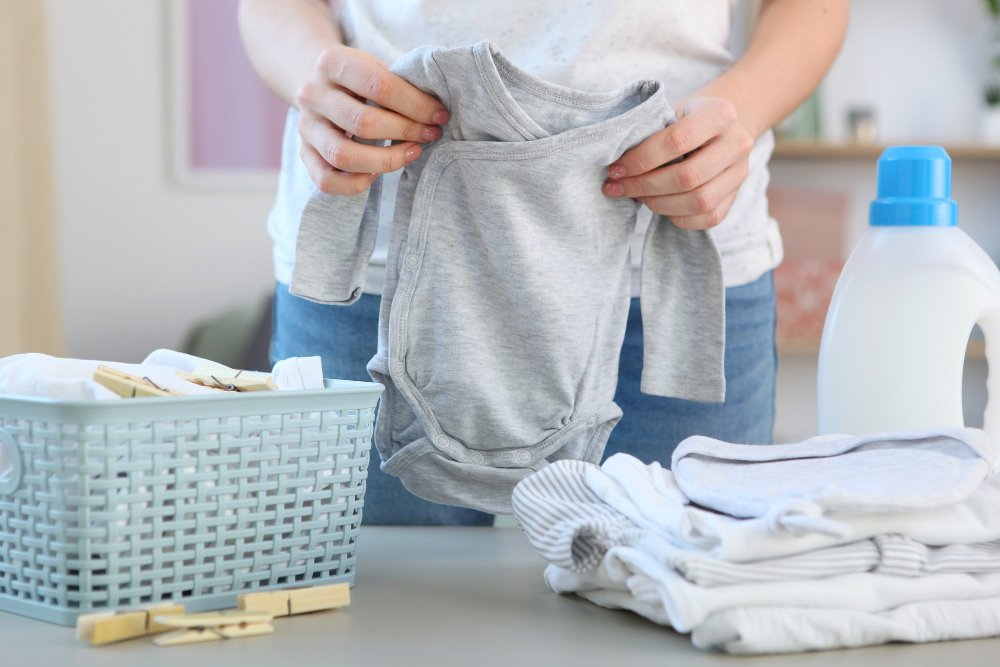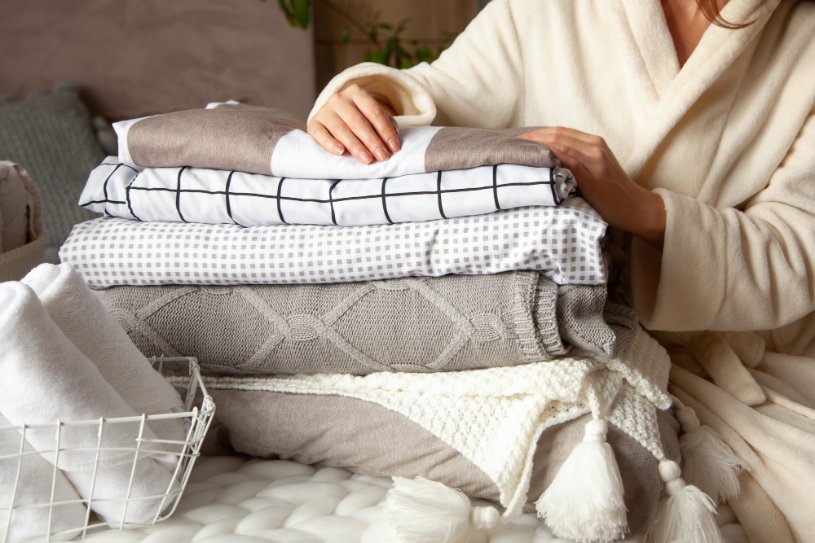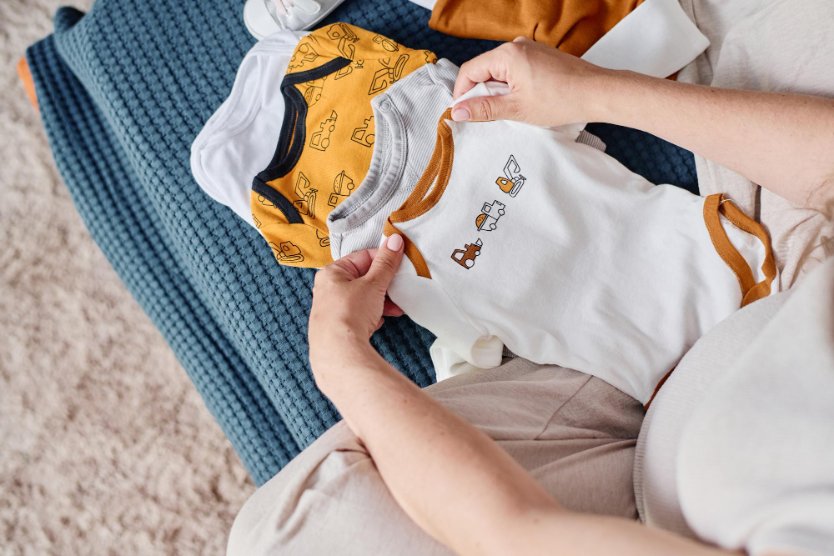Expert Guide to Washing Baby Clothes: Safety, Timing, and Best Practices for New Parents
Welcoming a new baby means welcoming mountains of tiny clothes into your life. As a parent, keeping those adorable outfits clean isn’t just about appearance, it’s about protecting your little one’s delicate skin. Washing baby clothes requires gentle detergent, proper sorting by color, and using the right water temperature to maintain fabric quality while removing common stains like spit-up and diaper blowouts.
Many new parents wonder if they need special detergent or separate loads for baby items. The answer depends on your baby’s skin sensitivity. Starting with a mild, fragrance-free detergent specially formulated for babies is recommended, especially during their first few months. Pre-treating stains before washing and checking all clothing labels for specific care instructions will save you time and frustration.
Baby clothes made from different materials require different care approaches. Cotton items can typically handle regular washing, while delicate fabrics need gentle cycles with cool water. Remember that even the softest fabrics can irritate sensitive skin if washed improperly, so taking a few extra minutes to wash baby clothes correctly is well worth the effort.
Table of Contents
Key Takeaways
- Use mild, fragrance-free detergent and pre-treat stains for best results when washing baby clothes
- Sort baby clothes by color and fabric type before washing to prevent damage and maintain quality
- Wash baby clothes 2-4 weeks before your due date to ensure freshness without dust accumulation
- Adjust washing methods based on fabric type and your baby’s skin sensitivity to prevent irritation
When to Wash Baby Clothes: Perfect Timing Guide
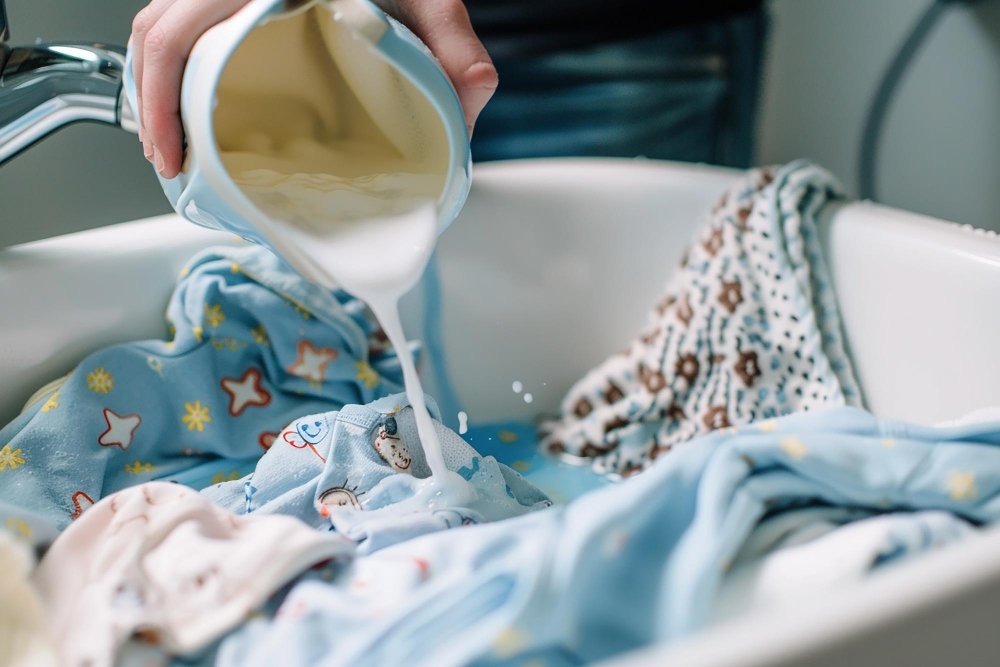
How Soon Before Baby Arrives Should You Wash Clothes?
The timing of when to wash baby clothes before birth is crucial for maintaining freshness while ensuring you’re prepared. Wash baby clothes 2-4 weeks before your due date. This timeframe ensures the clothes stay fresh without accumulating dust or losing that clean smell.
Is 32 Weeks Too Early to Wash Baby Clothes?
Yes, 32 weeks (about 8 weeks before due date) is generally too early to wash baby clothes. Washing them this early means they’ll sit for too long and may collect dust, potentially irritating your newborn’s sensitive skin, nose, and eyes.
Optimal Timing Schedule:
- 4-6 weeks before: Wash essential newborn items only (2-3 outfits, receiving blankets)
- 2-3 weeks before: Complete the main washing of all baby clothes
- Never earlier than 6 weeks: Clothes lose their fresh feel and may accumulate irritants
The Split-Wash Approach
Consider washing a few essential items at 4-6 weeks before your due date, then completing the rest closer to your delivery date. This strategy protects against early delivery while maintaining freshness for the majority of your baby’s wardrobe.
Choosing the Right Detergent for Baby Clothes
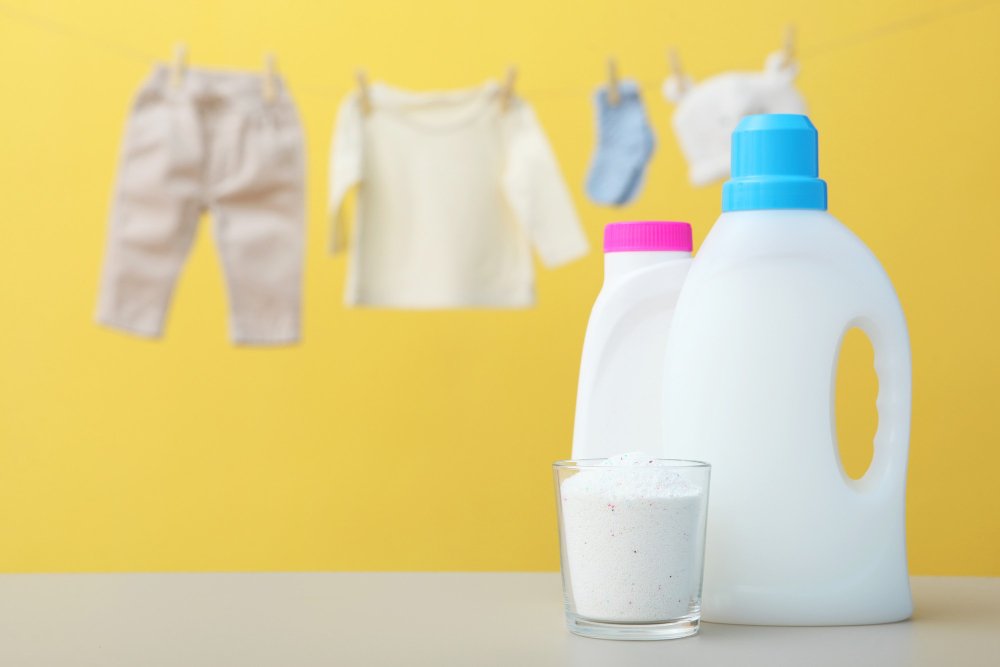
Do I Need Special Detergent for Baby Clothes?
While not absolutely required, baby-specific detergents are strongly recommended for newborns. Baby detergents are formulated without harsh chemicals, fragrances, and dyes that can irritate sensitive skin. Babies with particularly sensitive skin benefit most from specialized products.
What is the Best Detergent for Baby Clothes?
Top Recommended Baby Detergents:
- Dreft Stage 1: Newborn – Specially formulated for sensitive newborn skin
- All Free Clear – Fragrance and dye-free option
- Seventh Generation Free & Clear – Plant-based formula
- Babyganics Liquid Baby Detergent – Effective stain removal with gentle ingredients
Do You Really Need Baby Detergent?
You can transition to regular fragrance-free, dye-free detergent after your baby’s first few months, provided they don’t show skin sensitivity. Test wash one piece first to check for reactions.
A pediatrician breaks down what to look for in baby detergents and explains when special formulations are necessary:
Is Fairy Good for Baby Clothes?
Fairy Original can be used for baby clothes if your baby doesn’t have sensitive skin, but avoid versions with added fragrances or fabric conditioners. Always opt for the gentlest formulation available.
Essential Pre-Washing Steps
Do New Baby Clothes Need to be Washed Before Wearing?
Absolutely yes. All new baby clothes must be washed before first use to remove:
- Manufacturing chemicals and preservatives
- Excess dyes that could cause reactions
- Dust and potential allergens from storage and shipping
- Sizing agents that make clothes feel stiff
According to the American Academy of Pediatrics, washing all new baby clothes before first use is essential because newborns have sensitive skin and you don’t know who has handled the clothing during manufacturing and distribution.
Should I Wash Burp Cloths Before Use?
Yes, wash all burp cloths, muslins, and feeding accessories before first use. These items come into direct contact with your baby’s face and mouth, making pre-washing essential for safety.
Preparing Baby Clothes for First Wash
Pre-Washing Checklist:
- Remove all tags, stickers, and packaging
- Check pockets for any small items
- Fasten all snaps, buttons, and zippers to prevent snagging
- Sort by color: whites, lights, and darks
- Separate delicate items for gentler treatment
Inspecting for Safety
Before washing, check each item for:
- Loose buttons or snaps that could become choking hazards
- Sharp edges or broken hardware
- Loose threads that could wrap around tiny fingers
- Proper size labels to organize by growth stages
Understanding Wash Settings and Temperatures
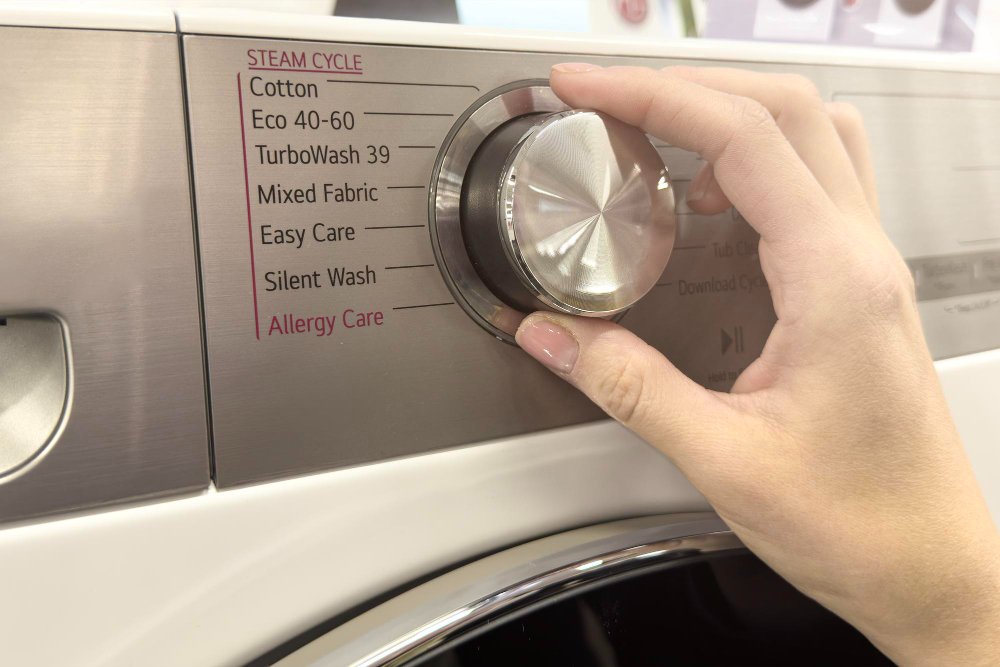
Should I Wash Baby Clothes at 30 or 40 Degrees?
30-40°C (86-104°F) is ideal for most baby clothes. This temperature effectively removes dirt and bacteria while being gentle on delicate fabrics and maintaining fabric quality.
Temperature Guidelines by Item Type:
- Regular clothes: 30-40°C
- Heavily soiled items: Up to 60°C (check care labels first)
- Delicate items: 30°C maximum
- Cloth diapers: 60°C for proper sanitization
Need help determining the right temperature for specific fabrics? Check our comprehensive Baby Clothes Temperature Guide by Fabric Type for detailed washing instructions for cotton, bamboo, wool, and other materials.
Is it Okay to Wash Baby Clothes in the Washing Machine?
Yes, standard washing machines are perfectly safe for baby clothes. Use these settings:
- Gentle or delicate cycle for most items
- Extra rinse cycle to remove all detergent residue
- Avoid overloading to ensure thorough cleaning
What Temperature to Wash Baby Bedding?
Wash baby bedding at 40-60°C depending on the fabric. Always check care labels, as some items like flame-resistant sleepwear have specific temperature requirements.
Proper Sorting and Organization
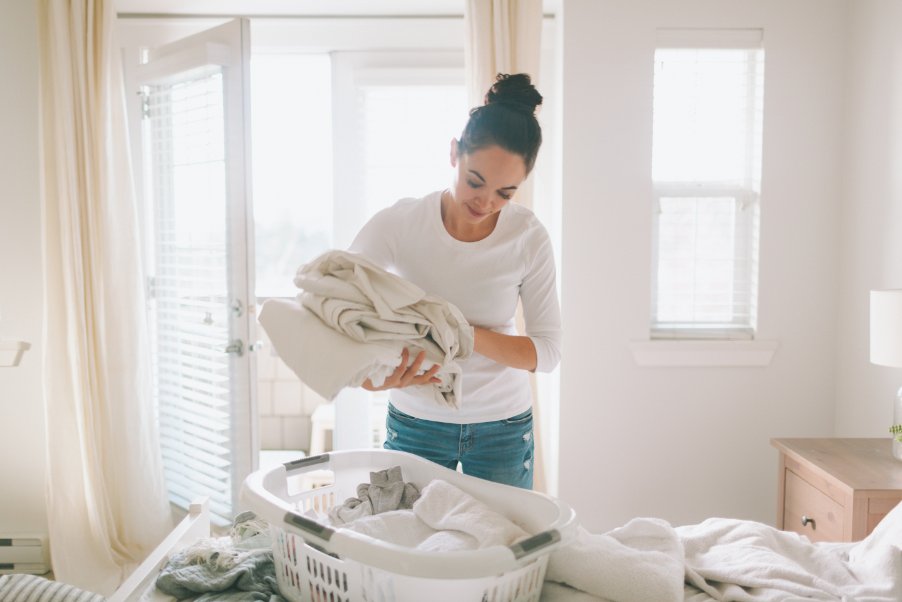
Do I Need to Separate Baby Clothes by Color?
Yes, always sort baby clothes by color to prevent color bleeding and fabric damage:
Sorting Categories:
- Whites: Onesies, socks, bibs
- Lights: Pastels and light colors
- Darks: Navy, black, deep colors
- Delicates: Lace items, special occasion outfits
Should Baby Clothes Be Washed Separately?
Wash baby clothes separately from adult clothing for the first 3-6 months. This prevents:
- Transfer of adult bacteria and germs
- Hair tourniquet risks from adult hair getting wrapped around baby’s fingers or toes
- Cross-contamination from stronger adult detergents
- Lost tiny items mixed in with larger clothes
Common Washing Mistakes to Avoid
Critical Safety Errors
Hair Tourniquet Prevention: Always wash baby clothes separately from adult laundry. Adult hair can wrap around baby’s tiny fingers or toes, cutting off circulation. This medical emergency requires immediate attention.
Detergent Overuse: Using too much detergent causes residue buildup that can irritate sensitive skin. Follow label instructions precisely and consider using less than recommended.
Ignoring Care Labels: Each baby garment may have specific requirements. Some fabrics need special treatment to maintain their protective properties.
Timing Mistakes
Washing Too Early: Clothes washed more than 6 weeks before use may accumulate dust and lose freshness.
Washing Too Late: Don’t wait until your due date as early delivery could leave you unprepared.
Incomplete Safety Checks: Always inspect clothes after washing for loose buttons, snaps, or hardware that could pose choking hazards.
Fabric Softener and Additional Products
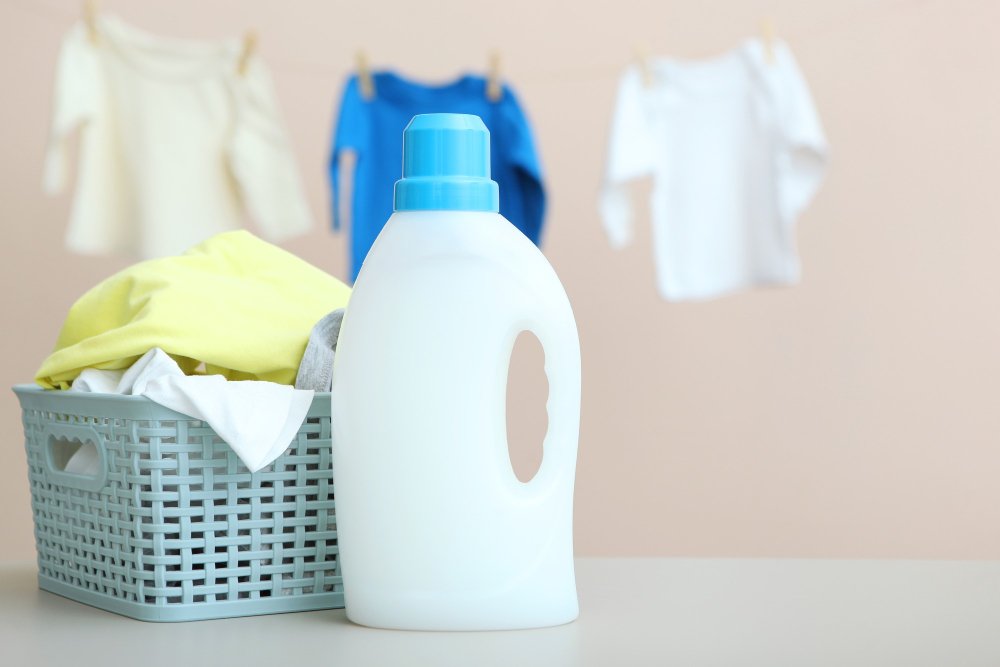
Should I Use Fabric Softener on Baby Clothes?
Avoid fabric softener on baby clothes entirely. Fabric softeners:
- Leave chemical residues that can irritate sensitive skin
- Reduce absorbency in cloth diapers
- Can diminish flame-resistance in sleepwear
- May cause allergic reactions in sensitive babies
Natural Alternatives to Fabric Softener
Safe Softening Options:
- White vinegar: Add 1/2 cup during rinse cycle for natural softening
- Baking soda: Add 1/2 cup to wash cycle to reduce soap residue
- Air drying: Natural method that maintains fabric softness
What Not to Use When Washing Baby Clothes
Avoid These Products:
- Fabric softeners and dryer sheets
- Bleach (unless specifically baby-safe)
- Strong stain removers with harsh chemicals
- Scented detergents
- Optical brighteners
Advanced Stain Removal Techniques
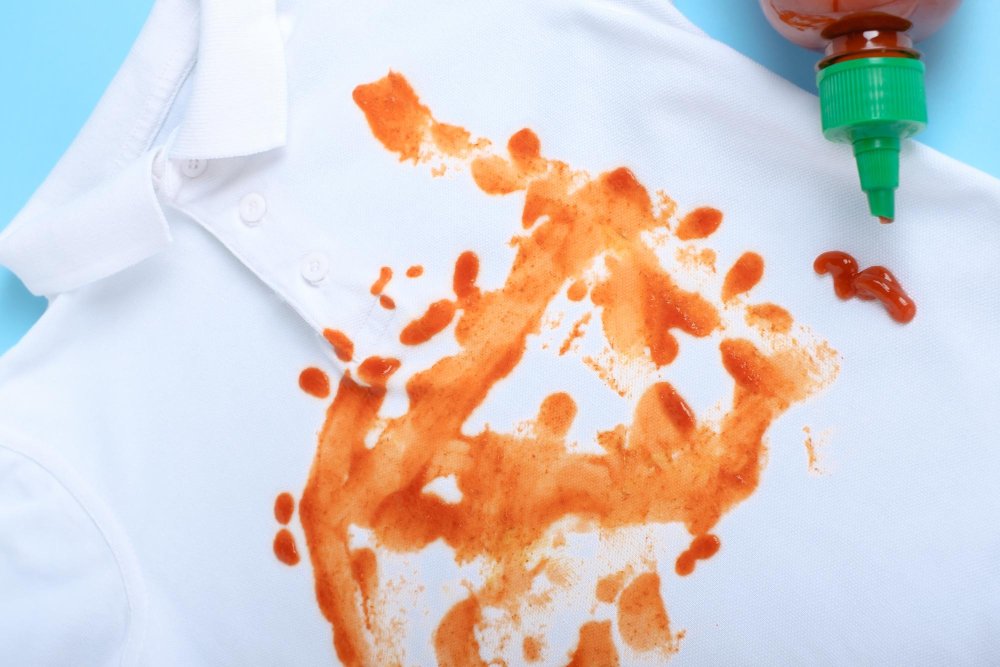
Protein-Based Stains (Formula, Breast Milk, Spit-Up)
Treatment Protocol:
- Rinse immediately with cold water (hot water “cooks” protein stains)
- Pre-treat with enzyme-based baby-safe stain remover
- Soak for 15-30 minutes in cold water
- Wash as normal with baby detergent
Oil-Based Stains (Baby Oil, Diaper Cream)
Effective Removal Method:
- Apply Dawn dish soap directly to stain
- Gently work in with soft brush
- Let sit for 15 minutes
- Wash in hottest water safe for fabric
- Air dry to check if stain is gone before machine drying
Diaper Blowout Emergency Protocol
Step-by-Step Cleanup:
- Remove solid waste carefully
- Rinse in cold water to remove residue
- Pre-treat with enzyme cleaner
- Soak in cold water for 1 hour
- Wash separately from other clothes
- Check stain removal before drying
For quick reference during stain emergencies, use our interactive Baby Clothes Stain Identification Chart to instantly identify the stain type and get the exact treatment method.
Fruit and Vegetable Stains
Natural Treatment:
- Rinse with cold water immediately
- Mix equal parts white vinegar and water
- Apply mixture and let sit 10 minutes
- Wash as normal
- For stubborn stains, try rubbing alcohol solution (1:1 with water)
Proper Drying Techniques
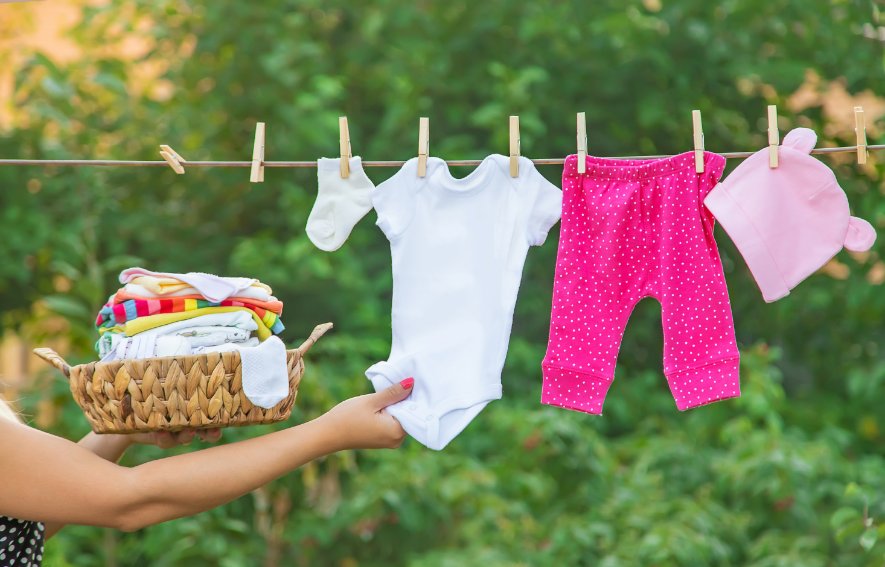
What is the Best Way to Dry Baby Clothes?
Air drying is the safest method for baby clothes. It prevents shrinkage, maintains fabric integrity, and eliminates heat-related damage.
Air Drying Benefits:
- Prevents shrinkage of tiny garments
- Maintains elastic integrity in waistbands
- Natural UV sanitization when dried outdoors
- Preserves fabric quality longer
Machine Drying Guidelines
If using a dryer:
- Use lowest heat setting (delicate/low)
- Remove while slightly damp to prevent over-drying
- Avoid overloading for even drying
- Check items frequently to prevent overheating
Should I Iron Newborn Clothes?
Ironing baby clothes isn’t necessary for hygiene but can be done for appearance. If ironing:
- Use low temperature setting
- Iron inside-out to protect prints
- Avoid ironing over snaps or buttons
- Consider the time investment vs. necessity
Essential Equipment and Tools
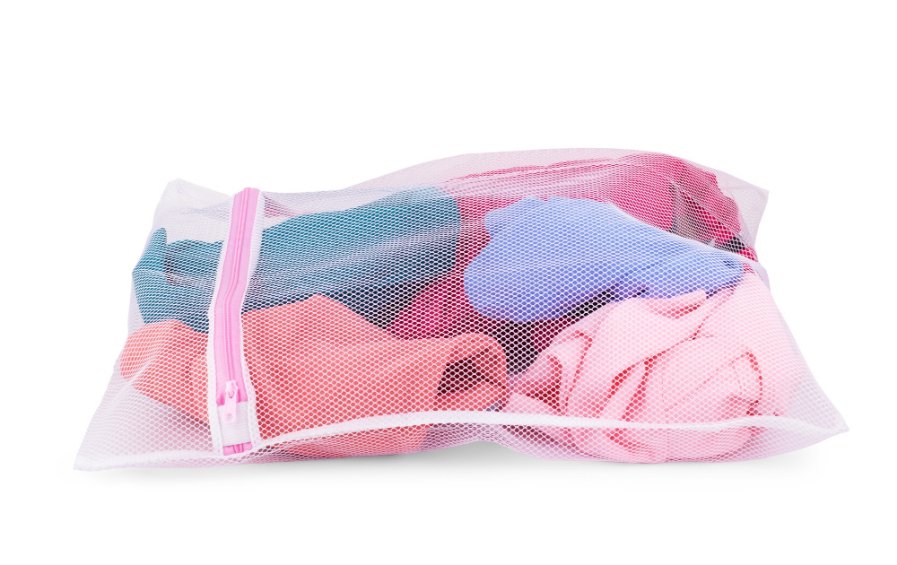
Must-Have Laundry Supplies for Baby Clothes
Basic Equipment:
- Mesh laundry bags for tiny socks and accessories
- Gentle baby-safe stain remover
- Soft-bristled brush for pre-treating stains
- Drying rack for air-drying delicate items
- Separate laundry baskets for sorting
Advanced Tools for Efficiency
Time-Saving Options:
- Baby-safe disinfectant spray for extra sanitization
- Enzyme-based pre-treatment sticks
- Color-catcher sheets for mixed loads (when baby is older)
- Multiple small baskets for easy sorting
Special Considerations for Sensitive Skin
Signs Your Baby Needs Gentler Care
Watch for these indicators:
- Persistent rashes or red marks where clothing touches skin
- Increased fussiness after wearing certain items
- Dry, flaky skin patches
- Excessive scratching or rubbing
For babies with compromised immune systems or those born prematurely, the CDC recommends extra sanitization measures for all items that come into contact with your baby, including clothing and feeding accessories.
Consulting Healthcare Providers
When to Seek Professional Advice:
- Chronic skin irritation despite gentle washing
- Suspected allergic reactions to clothing
- Persistent diaper rash that may be detergent-related
- Questions about skin conditions like eczema
Your pediatrician can recommend specific hypoallergenic products and washing routines tailored to your baby’s needs.
Quantity and Practical Planning
How Many Sleepsuits Does a Newborn Need?
Recommended Quantities:
- 8-10 sleepsuits in newborn size
- 8-10 onesies for daily wear
- 6-8 pairs of socks (they disappear frequently!)
- 4-6 receiving blankets
- 10-12 burp cloths for feeding times
Do Babies Need Non-Bio Washing Powder?
Non-biological (enzyme-free) detergents are gentler and recommended for babies with very sensitive skin. However, biological detergents often clean more effectively. Start with non-bio and switch to bio only if no skin reactions occur.
Washing Schedule and Frequency
Daily vs. Batch Washing
Daily Washing Approach:
- Smaller, manageable loads
- Fresh clothes always available
- Quick stain treatment possible
- Less overwhelming for busy parents
Weekly Batch Approach:
- More efficient use of water and energy
- Fewer interruptions to daily routine
- Risk of running out of essential items
- Potential for stains to set
To create the perfect washing routine for your family, use our Baby Clothes Washing Frequency Schedule to see exactly how often each type of clothing and accessory should be washed.
How Often Should You Wash Baby Items?
Washing Frequency Guide:
- After each wear: Onesies, outfits worn during meals
- Every 2-3 wears: Pants, sweaters (if no visible soiling)
- After each use: Burp cloths, bibs, feeding accessories
- Weekly: Blankets, sleep sacks (unless soiled)
Storage and Organization After Washing
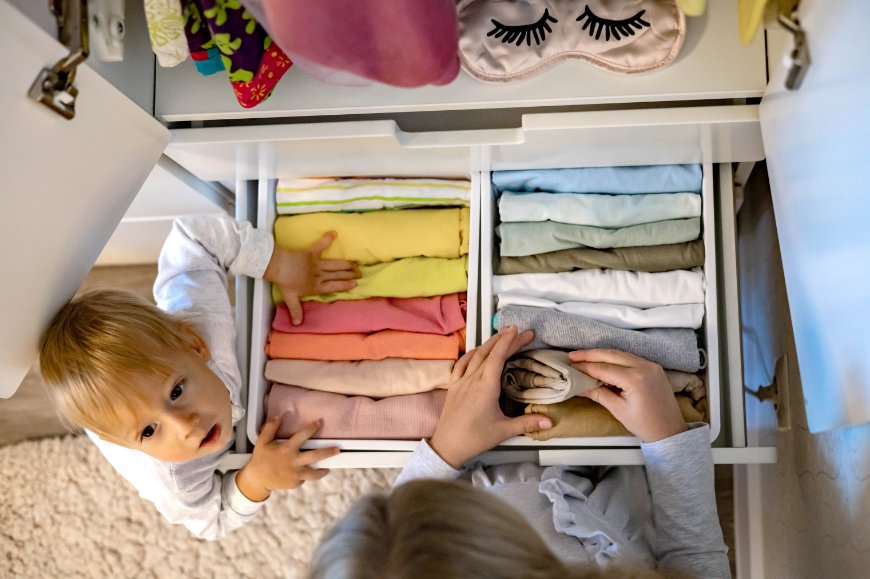
Proper Storage to Maintain Freshness
Storage Best Practices:
- Airtight containers for long-term storage
- Cedar balls or lavender sachets for natural freshness
- Organized by size for easy access as baby grows
- Protected from dust in closed drawers or containers
Organizing by Growth Stages
Size Organization System:
- Immediate use: Newborn to 3 months
- Next phase: 3-6 months ready for washing when needed
- Future sizes: Store unwashed until needed
Troubleshooting Common Issues
Dealing with Persistent Odors
Odor Elimination Techniques:
- White vinegar rinse: Add 1 cup to rinse cycle
- Baking soda treatment: Add 1/2 cup to wash cycle
- Sun drying: Natural odor elimination and sanitization
- Enzyme cleaners: For biological odors like spit-up
Addressing Detergent Residue
Signs of Residue Buildup:
- Clothes feel stiff or rough
- White powdery residue on dark clothes
- Skin irritation after wearing
- Reduced absorbency in cloth diapers
Solutions:
- Run extra rinse cycle
- Reduce detergent amount
- Switch to liquid detergent (rinses easier)
- Clean washing machine monthly
Managing Frequent Washing Concerns
Preventing Premature Wear:
- Turn clothes inside-out before washing
- Use mesh bags for delicate items
- Alternate between two sets of favorites
- Air dry whenever possible
Quick Reference Charts
Temperature Guide by Fabric Type
| Fabric Type | Recommended Temperature | Special Notes |
|---|---|---|
| Cotton | 30-40°C | Most versatile, can handle regular washing |
| Bamboo | 30°C | Very gentle cycle needed |
| Wool | 30°C | Hand wash or wool cycle only |
| Synthetic blends | 30-40°C | Check care label for specifics |
| Cloth diapers | 60°C | Higher temperature for sanitization |
Stain Treatment Quick Guide
| Stain Type | First Action | Treatment | Water Temp |
|---|---|---|---|
| Protein (milk, formula) | Rinse immediately | Enzyme cleaner | Cold |
| Oil-based (creams) | Don’t rinse | Dawn dish soap | Hot (fabric permitting) |
| Fruits/vegetables | Rinse immediately | Vinegar solution | Cold |
| Diaper blowouts | Remove solids first | Enzyme soak | Cold |
Interactive Tools for Baby Clothes Care
For hands-on help with your baby’s laundry routine, try these interactive tools:
- Baby Clothes Stain Identification Chart – Instantly identify stains and get treatment methods
- Temperature Guidelines by Fabric Type – Find the perfect washing temperature for any fabric
- Washing Frequency Schedule – Learn how often to wash different baby items.
Frequently Asked Questions
How to Wash Baby Clothes for the First Time?
First-Time Washing Steps:
1. Remove all tags and packaging materials
2. Sort by color and fabric type
3. Use baby-specific or fragrance-free detergent
4. Wash on gentle cycle with cold water
5. Run extra rinse cycle to remove all soap residue
6. Air dry or use low heat setting
For a step-by-step visual guide, watch this helpful tutorial
What is the Best Thing to Wash Baby Clothes With?
The best option is a baby-specific detergent like Dreft Stage 1 or a fragrance-free, dye-free alternative like All Free Clear. These formulations are designed to be gentle on sensitive skin while effectively cleaning baby messes.
How Long to Wait Before Washing a Baby?
This question typically refers to bathing, but if you mean when to start washing baby clothes, begin washing essential newborn items 2-4 weeks before your due date.
How to Wash Soiled Baby Clothes in a Washing Machine?
For Heavily Soiled Items:
1. Remove excess soil by rinsing or scraping
2. Pre-treat stained areas with enzyme cleaner
3. Soak in cold water for 30 minutes to 1 hour
4. Wash separately from lightly soiled items
5. Use warm water (40°C) if fabric allows
6. Run extra rinse cycle
7. Check stain removal before drying
Is Smol Non-Bio OK for Baby Clothes?
Smol Non-Bio can be suitable for baby clothes as it’s designed to be gentle and enzyme-free. However, always test on one item first and monitor your baby’s skin for any reactions.
What Washing Liquid to Use for Baby Clothes?
Top Liquid Detergent Options:
• Dreft Stage 1 Liquid – Purpose-built for newborns
• Seventh Generation Baby Liquid – Plant-based formula
• All Free Clear Liquid – Budget-friendly hypoallergenic option
• Babyganics Liquid – Effective stain removal with gentle ingredients
Liquid detergents generally rinse out more completely than powders, making them ideal for sensitive skin.
Conclusion
Washing baby clothes properly is essential for your little one’s health, comfort, and safety. The key principles are simple: use gentle, fragrance-free detergents, wash at appropriate temperatures (30-40°C for most items), and always pre-wash new clothes before first use. Timing your initial washing 2-4 weeks before your due date ensures freshness without dust accumulation.
Key Takeaways for Success
- Safety First: Always wash baby clothes separately from adult laundry to prevent hair tourniquet risks and cross-contamination. Inspect clothes after washing for loose buttons or hardware that could pose choking hazards.
- Gentle Approach: Avoid fabric softeners, dryer sheets, and harsh chemicals entirely. Natural alternatives like white vinegar and baking soda provide effective, safe solutions for softening and odor control.
- Proper Technique: Sort by color, pre-treat stains immediately, and use enzyme cleaners for protein-based messes. Air drying preserves fabric quality and prevents shrinkage of tiny garments.
- Smart Planning: Stock appropriate quantities (8-10 sleepsuits, 10-12 burp cloths) and establish a washing routine that works for your lifestyle, whether daily small loads or weekly batches.
- Responsive Care: Monitor your baby’s skin for reactions and adjust your routine accordingly. When in doubt, consult your pediatrician for personalized recommendations, especially if your baby has conditions like eczema.
Remember that every baby is different, and what works for one may not work for another. Start with the gentlest approach and gradually adjust based on your baby’s needs and skin sensitivity. The extra care you put into properly washing baby clothes pays dividends in your child’s comfort and health, making those precious early months more enjoyable for everyone.
Most importantly, don’t stress about achieving perfection. A few stains here and there won’t harm your baby, and the most important thing is maintaining cleanliness and safety. Focus on establishing a routine that keeps your baby comfortable while being sustainable for your family’s lifestyle.

